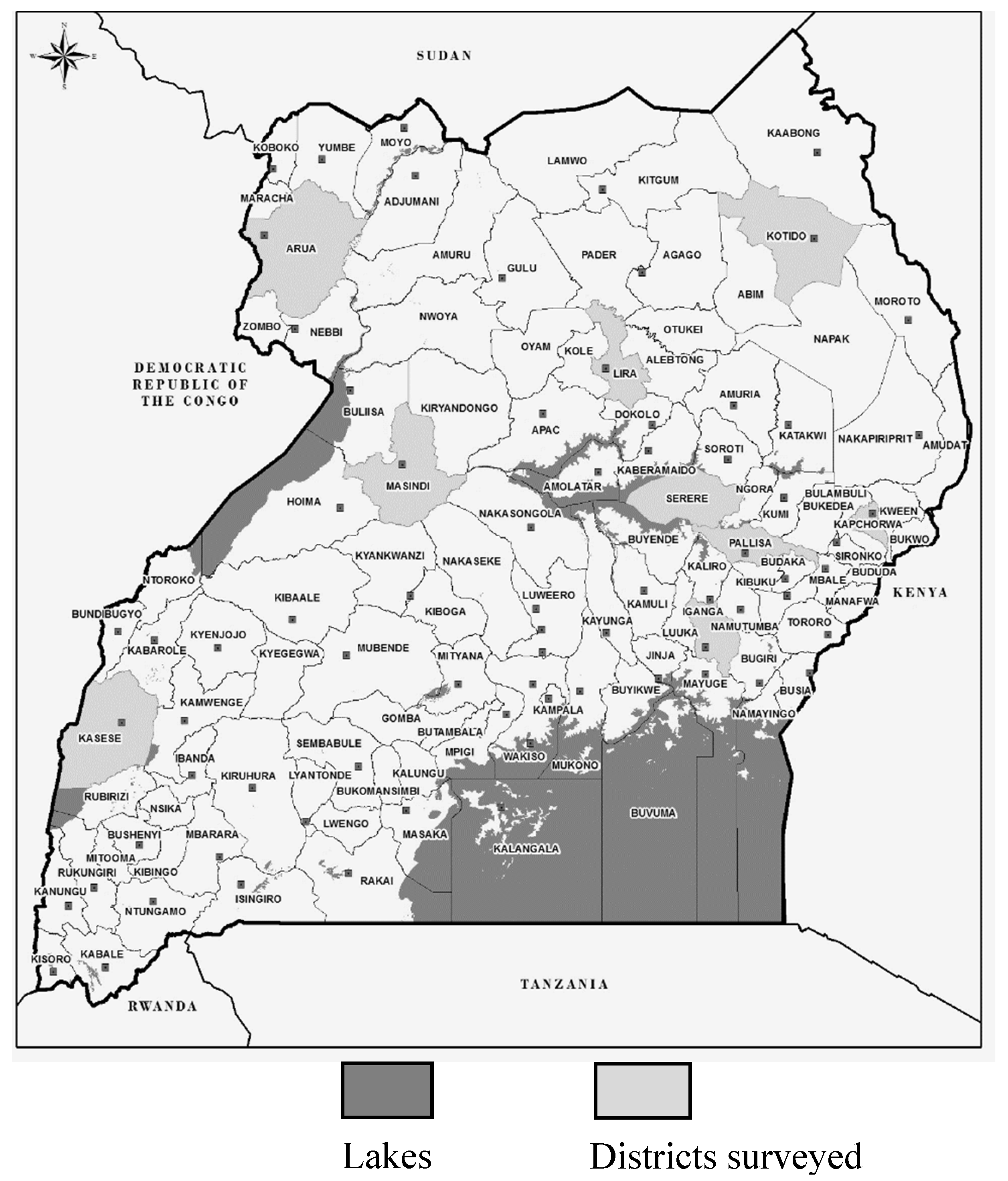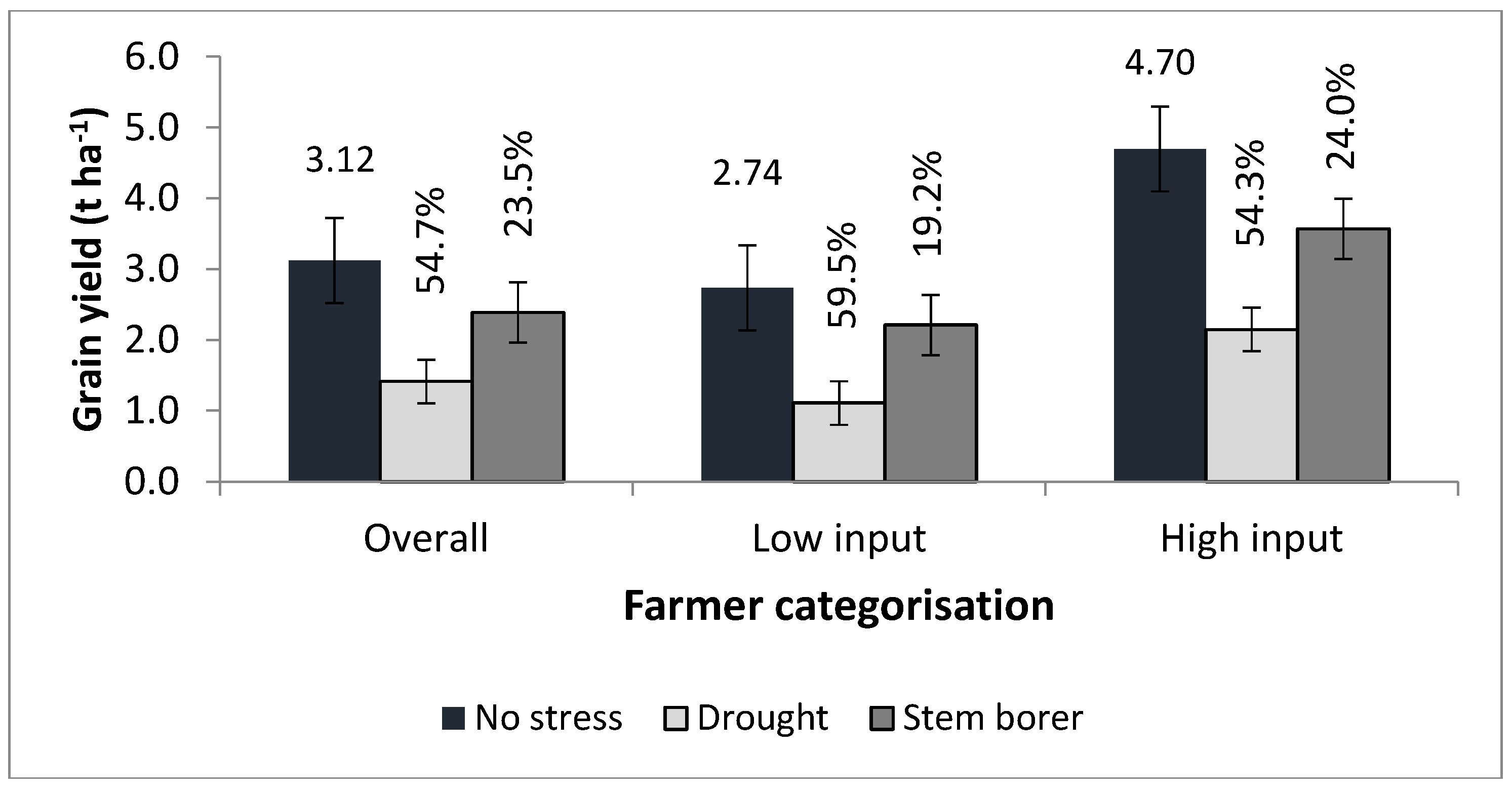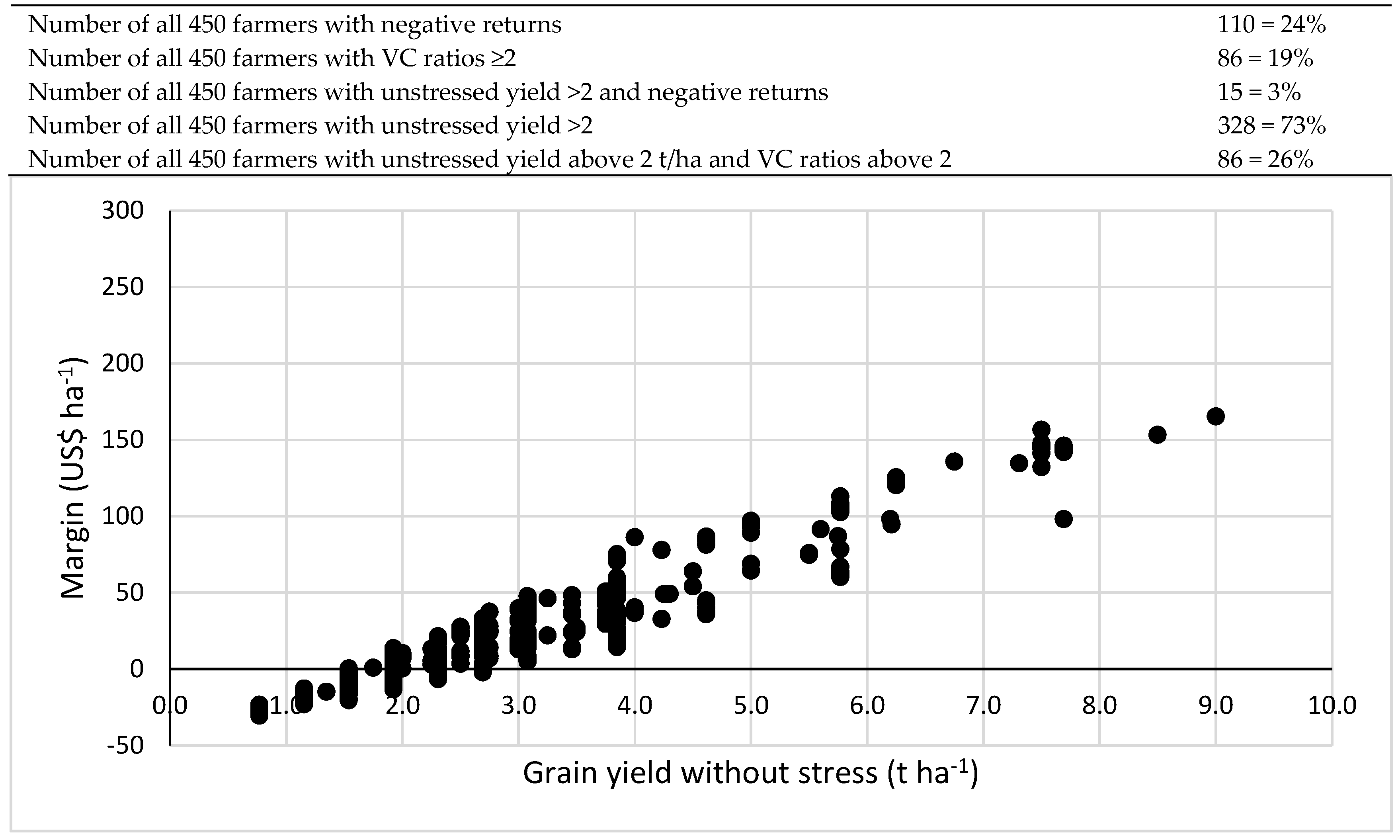A Survey: Potential Impact of Genetically Modified Maize Tolerant to Drought or Resistant to Stem Borers in Uganda
Abstract
:1. Introduction
2. Results
2.1. General Characteristics of Participating Farmers and Their Practices
2.2. Estimated Maize Yield Losses due to Drought and Stem Borer Damage
2.3. Projected Yield Gains of GM Maize over Conventional Maize Varieties
2.4. Regulatory Issues and Seed Sector
3. Discussion
3.1. Survey Results
3.2. Partial Budget Analysis
3.3. Policy and Seed Sector Issues
4. Materials and Methods
4.1. Study Area and Sampling Techniques
4.2. Data Collection
4.3. Partial Budgeting in Ex Ante Assessment
- Use of GM maize tolerant to drought versus conventional maize varieties under drought for all farmers;
- Use of GM maize resistant to stem borers versus conventional maize under high infestation of stem borers for all farmers;
4.4. Data Analysis
5. Conclusions
Acknowledgments
Author Contributions
Conflicts of Interest
References
- FAOSTAT. Global Area under Cultivation and Output Of Maize. 2013. Available online: http://faostat3.fao.org/ download/Q/QC/E (accessed on 10 October 2016).
- Haggblade, S.; Dewina, R. Staple food prices in Uganda. Available online: http://purl.umn.edu/58553 (accessed on 10 October 2016).
- Okoboi, G.; Muwanga, J.; Mwebaze, T. Use of Improved Inputs and Its Effect on Maize Yield and Profit in Uganda. Available online: http://www.ajol.info/index.php/ajfand/article/view/84204 (accessed on 10 October 2016).
- Uganda Bureau of Statistics. 2012 Statistical Abstract. Available online: http://www.ubos.org/onlinefiles/uploads/ubos/pdf%20documents/2012StatisticalAbstract.pdf (accessed on 10 October 2016).
- Heisey, P.W.; Edmeades, G.O. World Maize Facts and Trends 1997/98. Available online: http://citeseerx.ist.psu.edu/viewdoc/download?doi=10.1.1.944.6485&rep=rep1&type=pdf (accessed on 10 October 2016).
- Edmeades, G.O. Drought tolerance in maize: An emerging reality; International Service for the Acquisition of Agri-Biotech Applications (ISAAA): Ithaca, NY, USA, 2008. [Google Scholar]
- De Groote, H.; Overholt, B.; Ouma, L.; Mugo, S. Assessing the potential impact of Bt maize in Kenya using a GIS based model. In Proceedings of the 25th International Conference of the International Association of Agricultural Economists, Durban, South Africa, 16–22 August 2003.
- Edmeades, G. Progress in achieving and delivering drought tolerance in Maize - an update; International Service for the Acquisition of Agri-Biotech Applications (ISAAA): Ithaca, NY, USA, 2013. [Google Scholar]
- James, C. Global Review of Commercialized Transgenic Crops; International Service for the Acquisition of Agri-Biotech Applications (ISAAA): Ithaca, NY, USA, 2003. [Google Scholar]
- Wu, F.; Miller, J.D.; Casman, E.A.; Abbas, H.K. Bt corn and mycotoxin reduction: an economic perspective. In Aflatoxin and food safety; CRC Press: New York, NY, USA, 2005. [Google Scholar]
- Smale, M.; Zambrano, P.; Gruère, G.; Falck-Zepeda, J.; Matuschke, I.; Horna, J.D.; Nagarajan, L. Measuring the economic impacts of transgenic crops in developing agriculture during the first decade: approaches, findings, and future directions; International Food Policy Research Institute: Washington, DC, USA, 2009. [Google Scholar]
- Edmeades, S.; Smale, M. A Trait-based model of the potential demand for a genetically engineered food crop in a developing economy. Agric. Econ. 2006, 35, 351–361. [Google Scholar] [CrossRef]
- Horna, J.D.; Smale, M.; Al-Hassan, R.; Falck-Zepeda, J.; Timpo, S.E. Insecticide Use on Vegetables in Ghana: Would GM Seed Benefit Farmers? Available online: http://ageconsearch.umn.edu/bitstream/6506/2/462466.pdf (accessed on 10 October 2016).
- Vitale, J.D.; Vognan, G.; Ouattarra, M.; Traore, O. The commercial application of GMO crops in Africa: Burkina Faso’s decade of experience with Bt cotton. Available online: http://soybeaninnovationlab.illinois.edu/sites/soybeaninnovationlab.illinois.edu/files/cotton%20prfotiabilityv13n4a05-vitale.pdf (accessed on 10 October 2016).
- Mwebaze, S.M. Country pasture/forage resource profiles. Grasslands and Pasture Crops. 2002. Available online: http://www.fao.org/ag/AGP/AGPC/doc/Counprof/Uganda.htm (accessed on 10 October 2016).
- MAAIF. The Seed and Plant Act, 2006; Uganda Printing and Publishing Corporation: Entebbe, Uganda, 2006. [Google Scholar]
- MAAIF. The Plant Protection and Health Act, 2014; Uganda Printing and Publishing Corporation: Entebbe, Uganda, 2015. [Google Scholar]
- MAAIF. Plant Variety Protection Act, 2014; Uganda Printing and Publishing Corporation: Entebbe, Uganda, 2014. [Google Scholar]
- MFPED. National Biotechnology and Biosafety Policy; Uganda Printing and Publishing Corporation: Entebbe, Uganda, 2008. [Google Scholar]
- FAO. A data portrait of smallholder farmers: An introduction to a dataset on small-scale agriculture. 2016. Available online: http://www.fao.org/economic/esa/esa-activities/esa-smallholders/dataportrait/farm-size/en/ (accessed on 10 October 2016).
- De Groote, H.; Mugo, S.; Bergvinson, D.; Odhiambo, B. Debunking the myths of GM crops for Africa: The case of Bt maize in Kenya. In Proceedings of the American Agricultural Economics Association Annual Meetings, Denver, Colorado, 1–4 August 2004.
- Hisali, E.; Birungi, P.; Buyinza, F. Adaptation to climate change in Uganda: evidence from micro level data. Glob. Environ. Change 2011, 21, 1245–1261. [Google Scholar] [CrossRef]
- Pandey, S. Adoption of nutrient management technologies for rice production: economic and institutional constraints and opportunities. Nutr. Cycl. Agroecosyst. 1999, 53, 103–111. [Google Scholar] [CrossRef]
- Haefele, S.M.; Kato, Y.; Singh, S. Climate ready rice: augmenting drought tolerance with best management practices. Field Crops Res. 2016, 190, 60–69. [Google Scholar] [CrossRef]
- Ajala, O.; Saxena, N. Interrelationship among chilo partellus (SWINHOE) damage parameters and their contribution to grain yield reduction in maize (Zea mays L.). Appl. Entomol. Zool. 1994, 29, 469–476. [Google Scholar]
- De Groote, H. Maize yield losses from stemborers in Kenya. Int. J. Trop. Insect. Sc. 2002, 22, 89–96. [Google Scholar] [CrossRef]
- Mgoo, V.H.; Makundi, R.H.; Pallangyo, B.; Schulthess, F.; Jiang, N.; Omwega, C.O. Yield Loss Due to The Stemborer Chilo Partellus (Swinhoe) (Lepidoptera: Crambidae) at Different Nitrogen Application Rates to Maize. Available online: http://www.tandfonline.com/doi/abs/10.1080/00379271.2006.10697483 (accessed on 10 October 2016).
- Fuglie, K.; Ballenger, N.; Day, K.; Klotz, C.; Ollinger, M.; Reilly, J.; Vasavada, U.; Yee, J. Agricultural research and development: Public and private investments under alternative markets and institutions. Available online: https://www.ers.usda.gov/publications/pub-details/?pubid=40696 (accessed on 10 October 2016).
- Gouse, M.; Pray, C.E.; Kirsten, J.; Schimmelpfennig, D.A. GM subsistence crop in Africa: the case of Bt white maize in South Africa. J. Biotechnol. 2005, 7, 84–94. [Google Scholar]
- Janaiah, A. Hybrid rice adoption in India: Farm-level impacts and challenges. Available online: https://www.scribd.com/document/50246052/Hybrid-Rice-Adoption-in-India-Farm-Level-Impacts-and-Challenges-TB-14 (accessed on 10 October 2016).
- Tollenaar, M.; Wu, J. Yield improvement in temperate maize is attributable to greater stress tolerance. Crop Sci. 1999, 39, 1597–1604. [Google Scholar] [CrossRef]
- Perrin, R.K.; Winkelmann, D.L.; Moscardi, E.R.; Anderson, J.R. From Agronomic Data to Farmer Recommendations: An Economics Training Manual. Available online: http://impact.cgiar.org/agronomic-data-farmer-recommendations-manual-economic-evaluation (accessed on 10 October 2016).
- Labatte, J.-M.; Meusnier, S.; Migeon, A.; Chaufaux, J.; Couteaudier, Y.; Riba, G.; Got, B. Field evaluation of and modeling the impact of three control methods on the larval dynamics of Ostrinia nubilalis (Lepidoptera: Pyralidae). J. Econ. Entomol. 1996, 89, 852–862. [Google Scholar] [CrossRef]
- KocoureK, F.; Stara, J. Efficacy of Bt maize against European corn borer in Central Europe. Plant Prot. Sci. 2012, 48, 25–35. [Google Scholar]
- Ingram, W. The lepidopterous stalk borers associated with Gramineae in Uganda. Bull. Entomol. Res. 1958, 49, 367–383. [Google Scholar] [CrossRef]
- Wale, M.; Schulthess, F.; Kairu, E.; Omwega, C. Cereal yield losses caused by lepidopterous stemborers at different nitrogen fertilizer rates in Ethiopia. J. Appl. Entomol. 2006, 130, 220–229. [Google Scholar] [CrossRef]
- Gouse, M. GM maize as subsistence crop: The South African smallholder experience. AgBioForum 2012, 15, 163–174. [Google Scholar]
- NARO and AATF. Enhancing Maize Productivity in Uganda through WEMA Project; National Agricultural Research Organisation and African Agricultural Technology Foundation: Entebbe, Uganda, 2010. [Google Scholar]
- Doye, D.G.; Coe, N. Wheat grazeout versus harvest for grain: Division of Agricultural Sciences and Nanarotural Resources; Oklahoma State University: Stillwater, Oklahoma, USA, 2001. [Google Scholar]
- Lane, D.M.; Rendleman, C.M.; Ott, S.L. Using partial budgets to analyze selected management practices associated with reduced preweaning mortality. Swine Health Prod. 1997, 3, 95–102. [Google Scholar]
- Sharma, B.P. Measuring the price of labour in agricultural economies: the shadow wage rate. J. Dev. Issues 2015, 15, 24–35. [Google Scholar] [CrossRef]





| Characteristic | District | |||||||||
|---|---|---|---|---|---|---|---|---|---|---|
| Mean | Lira | Kotido | Serere | Arua | Masindi | Kapchorwa | Kasese | Iganga | Pallisa | |
| Gender of household head (1 = male, 0 = female) | 0.90 | 0.90 | 0.94 | 0.94 | 0.88 | 0.90 | 0.94 | 0.88 | 0.82 | 0.86 |
| Age of household head | 43.6 | 44.7 | 39.7 | 42.6 | 42.3 | 42.9 | 44.0 | 47.9 | 44.3 | 43.6 |
| Education level of household head (years) | 6.4 | 7.1 | 4.0 | 7.2 | 5.4 | 6.4 | 8.3 | 5.4 | 5.2 | 8.3 |
| Household members | 7.4 | 6.6 | 6.9 | 7.9 | 5.9 | 6.6 | 7.4 | 7.7 | 8.8 | 8.5 |
| Experience with maize (years) | 15.5 | 14.9 | 5.1 | 14.1 | 15.3 | 15.7 | 19.1 | 17.3 | 21.7 | 16.0 |
| Total land holdings (ha) | 2.7 | 2.6 | 4.2 | 2.5 | 2.2 | 4.1 | 2.9 | 2.1 | 1.9 | 1.7 |
| Total maize area (ha) | 1.2 | 1.1 | 1.0 | 0.9 | 0.6 | 2.0 | 1.7 | 1.3 | 1.3 | 0.7 |
| Access to AES * (1 = yes) | 0.4 | 0.6 | 0.4 | 0.2 | 0.5 | 0.5 | 0.6 | 0.6 | 0.3 | 0.2 |
| District * | Improved Seed (%) | Inorganic Fertilizer (%) | Pesticides (%) | Drought Yield Loss (%) ** | Stem Borer Yield Loss (%) ** |
|---|---|---|---|---|---|
| Lira | 44 | 10 | 8 | 55.7 | 35.9 |
| Kotido | 10 | 2 | 0 | 66.7 | 36.5 |
| Serere | 14 | 2 | 12 | 62.5 | 17.1 |
| Arua | 06 | 2 | 0 | 54.1 | 30.6 |
| Masindi | 80 | 50 | 36 | 48.0 | 12.7 |
| Kapchorwa | 100 | 84 | 46 | 52.6 | 18.5 |
| Kasese | 24 | 6 | 2 | 59.8 | 14.8 |
| Iganga | 16 | 8 | 2 | 57.1 | 25.6 |
| Pallisa | 52 | 2 | 8 | 55.7 | 26.6 |
| Partial Budget Element | Units ** | Conventional Seed * | Drought Tolerant Hybrid Seed * |
|---|---|---|---|
| Maize grain yield | t·ha−1 | 1.98 *** | 2.46 *** |
| Price of maize grain | USD·kg−1 | 0.11 | 0.11 |
| Total income | USD·ha−1 | 224.9 | 279.7 |
| Probability of drought | % | 67 | 67 |
| Technology fees | % | 0 | 35 |
| Cost of seed (25 kg·ha−1) | USD·ha−1 | 19.4 | 48.2 |
| Technology efficacy | % | 0 | 25 |
| Total costs that vary | USD·ha−1 | 19.4 | 48.2 |
| Net benefits | USD·ha−1 | 205.5 | 231.5 |
| Margin | USD·ha−1 | 26.0 | |
| Value/cost ratio | 1.54 | ||
| Costs/Income | Units ** | Conventional Seed * | Bt Hybrid Maize Seed * |
|---|---|---|---|
| Yield | t·ha−1 | 2.63 *** | 3.31 *** |
| Price of maize grain | USD·kg−1 | 0.11 | 0.11 |
| Total income | USD·ha−1 | 297.4 | 375.4 |
| Probability of stem borer damage | % | 67 | 67 |
| Technology fees | % | 0 | 35 |
| Cost of seed (25 kg·ha−1) | USD·ha−1 | 19.4 | 48.2 |
| Cost of pesticides | USD·ha−1 | 3.4 | 0 |
| Labour to apply pesticides | USD·ha−1 | 1.2 | 0 |
| Technological efficacy | % | 0 | 85 |
| Total costs that vary | USD·ha−1 | 24.0 | 48.2 |
| Net benefits | USD·ha−1 | 273.4 | 327.2 |
| Margin | USD·ha−1 | 54.2 | |
| Value/cost ratio | 2.13 | ||
© 2017 by the authors. Licensee MDPI, Basel, Switzerland. This article is an open access article distributed under the terms and conditions of the Creative Commons Attribution (CC BY) license ( http://creativecommons.org/licenses/by/4.0/).
Share and Cite
Wamatsembe, I.M.; Asea, G.; Haefele, S.M. A Survey: Potential Impact of Genetically Modified Maize Tolerant to Drought or Resistant to Stem Borers in Uganda. Agronomy 2017, 7, 24. https://doi.org/10.3390/agronomy7010024
Wamatsembe IM, Asea G, Haefele SM. A Survey: Potential Impact of Genetically Modified Maize Tolerant to Drought or Resistant to Stem Borers in Uganda. Agronomy. 2017; 7(1):24. https://doi.org/10.3390/agronomy7010024
Chicago/Turabian StyleWamatsembe, Isaac M., Godfrey Asea, and Stephan M. Haefele. 2017. "A Survey: Potential Impact of Genetically Modified Maize Tolerant to Drought or Resistant to Stem Borers in Uganda" Agronomy 7, no. 1: 24. https://doi.org/10.3390/agronomy7010024
APA StyleWamatsembe, I. M., Asea, G., & Haefele, S. M. (2017). A Survey: Potential Impact of Genetically Modified Maize Tolerant to Drought or Resistant to Stem Borers in Uganda. Agronomy, 7(1), 24. https://doi.org/10.3390/agronomy7010024







